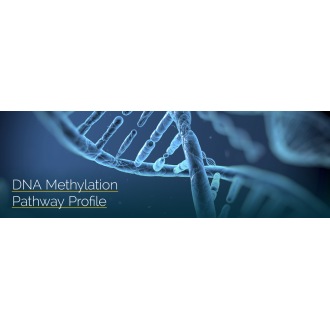DNA Methylation Pathway Profile Test by GPL
- Brand: Mosaic Diagnostics - Testing
- Product Code: GPL016
- Availability: In Stock
-
INR 63,661.00
- Ex Tax:
INR 63,661.00
NOTE :
1) TEST KITS WILL BE SHIPPED BY MATRITOUCH.COM
2) SAMPLES WILL BE PICKED UP BY FEDEX AND DIRECTLY DELIVERED TO THE GREAT PLAINS LABORATORY IN USA.
3) THE REPORTS WILL BE SENT BY EMAIL ONLY & NOTIFICATION WILL BE GIVEN OVER PHONE.
4) PLEASE ALSO READ THE FAQ's FOR TESTS
GENERAL
The DNA Methylation Pathway Profile allows clinicians to screen their patients for a variety of genetic changes (single nucleotide polymorphisms, or SNPs) that may impact the function of important biochemical processes such as methionine metabolism, detoxification, hormone balance and Vitamin D function. The presence or absence of SNPs may modify disease risk. The risks may be reduced by lifestyle changes, and inefficient biochemical processes can be supported by diet and nutritional supplements to maximize the functions of metabolic pathways.
Identifying SNPs that may influence health and risk for diseases facilitates clinical support for patients. The DNA Methylation Pathway Profile includes a variety of SNPs known to influence many aspects of health including those for:
- Insulin Sensitivity
- Bone Health
- Cancer Risks
- Cardiovascular Health
- Detoxification Processes
- Fertility
- Mitochondrial Function and Metabolism
- Methylation
- Neurotransmitter Balance
IMPORTANT SNPS IN THE PROFILE
VDR: (the vitamin D receptor) is a nuclear receptor protein that binds 1,25-dihydroxy vitamin D to activate a signaling molecule that is believed to have important roles in a 3rd of the human genome. Some functions that are known are xenobiotic detoxification.
BHMT: (betaine-homocysteine methylatransferase) is a transferase enzyme that catalyzes the transfer of a methyl group from betaine to homocysteine, which produces methionine. Other enzymatic roles for BHMT is the choline oxidation processes. This enzyme is found in the liver and kidney.
COMT: (catechol-O-methyltransferase) functions in the nerve cells, liver, kidneys, and red blood cells. Its role is to help inactivate 2- and 4-hydroxyestradiols, and catecholamine hormones prior to excretion of bile. COMT is also found in the CNS where its role is the degradation of catecholamine neurotransmitters.
MAO A: (monoamine oxidase type A) its main role is to detoxify biological and xenobiotic amines. This enzyme also degrades neurotransmitters in both the central and peripheral nervous system.
AHCY: (adenosylhomocysteinase) an enzyme that breaks down methionine by converting S-adenosylhomocysteinase into homocysteine. This reaction regulates the methylation of other compounds.
CBS: (cystathionine beta-synthase) this enzyme is responsible for using vitamin B6 to convert serine and homocysteine into cystothionine which will be later converted into cysteine.
MTHFR: (methylenetetrahydrofolate reductase) enzyme responsible for the conversion of 5,10-methylenetetrahydrofolate to 5-methyltetrahydrofolate. This reaction allows for the conversion of homocysteine to methionine.
MTR: (methionine synthase) enzyme that catalyzes the re-methylation of homocysteine to methionine using the methyl-B-12 as a cofactor.
MTRR: (methionine synthase reductase) responsible for the regeneration of methyl-B-12.
SHMT: (serine hydroxymethyltransferase) responsible for catalyzing the interconversion of glycine to serine.
SUOX: (sulfite oxidase) mitochondrial enzyme responsible for oxidizing sulfites to sulfates. Sulfites are produced by the transsulfuration cycle or from diet.
The identification of SNPs and their impact on health and physiology is an ongoing area of research – the hope is that finding and studying these small variations in DNA will lead to better and more individualized medical interventions. In many cases the environment – diet, nutrition, toxicant exposures, stress - may further modify the expression of genes and SNPs.
The SNPs affecting detoxification and methylation become even more important if a patient has been exposed to the toxicants such as mercury, lead or bisphenol A (BPA). Lead and BPA inhibit the function of methyltransferases, and mercury inhibits methionine synthase, an important enzyme in the re-methylation of homocysteine. Methylation is an essential step in the detoxification and elimination of arsenic and other xenobiotics. Normal methionine metabolism is a critical component of Phase II detoxification processes; the B-12 and folate-dependent transmethylation and B-6 dependent transsulfuration pathways convert homocysteine to cysteine. Cysteine is an important precursor in glutathione biosynthesis.
The greatest difficulty in interpreting SNP results is determining the extent to which a DNA genotype is phenotypically expressed. Other metabolic tests, such as our Organic Acids Test (OAT), combined with evaluation of the patient’s symptoms and responses to intervention, are necessary to assess the influence of known SNPs on the phenotype. Identifying SNPs that influence health and disease risk allows clinicians to support their patients with appropriate lifestyle changes and nutrition to maximize health and wellness.
THE BENEFITS OF DNA METHYLATION TESTING
- Clarification of diagnosis suggested by other testing
- Indication for supplements and diet modifications
SPECIMEN REQUIREMENTS
Dried Blood Spot (DBS): Five full circles of dried blood on the protein saver card is required.

